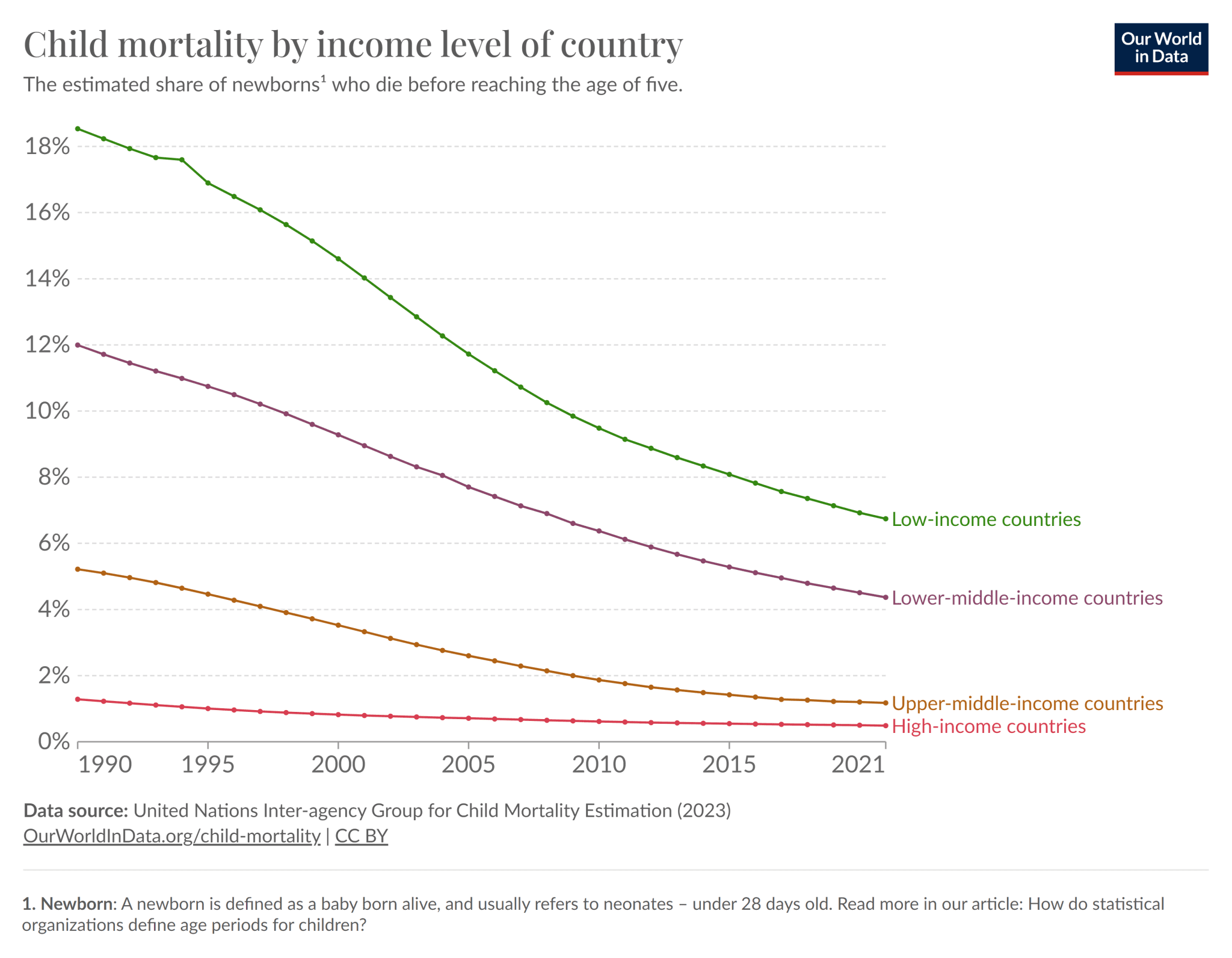What Is Child Mortality?
Child mortality, measured by most organizations as the number of deaths of children under the age of five, is simultaneously one of our most pressing global challenges and a remarkable success story for the international community. Rates of child mortality have declined by over 50 percent since 1990, reflecting global advancements in nutrition, medicine, sanitation, and other critical areas.
Yet rates of child mortality have remained stubbornly high in some parts of the world, and the trend toward reducing child mortality rates has stagnated globally for over a decade. Today, over 80% of child deaths occur in sub-Saharan Africa and South Asia. The UN Sustainable Development Goals aim to reduce every country’s child mortality rate to less than 25 deaths per every 1,000 children, but 54 countries are set to miss this target by 2030. Significant progress is still needed to avoid millions of preventable deaths worldwide for children under five.

What is the Leading Cause of Child Mortality?
Assessing the causes of child mortality is not an easy question. Data on child and newborn death statistics is generally collected at a country level, but not every country’s government has the infrastructure or funding to collect high quality data, assuming they are able to collect any data at all. Around half of all countries have been unable to collect child mortality data for the past five years, and only 36 countries have collected data considered “high quality” by the UN Inter-Agency Group for Child Mortality Estimations.
Because of this gap in data collection, it may be difficult to point to any number one cause of death among children. Most international organizations that keep track of this kind of data, like the World Health Organization, instead point to a cluster of leading causes of death as being the primary concerns for child mortality. These causes include lack of appropriate neonatal care, malnutrition, and infectious disease. About half of all child deaths under the age of five occur within the first month of life.
Leading Cause of Child Mortality in the U.S.
 Child mortality in wealthy countries looks very different than it does in countries with less wealth. For instance, the leading cause of death among children in the U.S. under the age of five is unintentional injuries for children ages 1 to 4 and birth defects for children under the age of one. In the United States, infectious diseases like pneumonia and influenza cause fewer deaths than intentional homicide. The child mortality rate in the U.S. is one of the highest rates of child mortality among wealthy nations: it ranks at the bottom of all OECD countries on this metric. The health outcomes for the world’s poorest children are even more disparate from those of children living in a country like Norway.
Child mortality in wealthy countries looks very different than it does in countries with less wealth. For instance, the leading cause of death among children in the U.S. under the age of five is unintentional injuries for children ages 1 to 4 and birth defects for children under the age of one. In the United States, infectious diseases like pneumonia and influenza cause fewer deaths than intentional homicide. The child mortality rate in the U.S. is one of the highest rates of child mortality among wealthy nations: it ranks at the bottom of all OECD countries on this metric. The health outcomes for the world’s poorest children are even more disparate from those of children living in a country like Norway.
How Can Child Mortality Be Reduced?
The global stall in reducing child mortality rates makes sense when considering the complex set of factors contributing to these deaths. Improving access to health care may stand out as an immediate way to reduce child mortality, as many child deaths are caused by lack of pregnancy care or routine immunizations. But doing something as beneficial as building a health clinic may reveal a myriad of interrelated problems.
 If the health clinic doesn’t have access to clean water or electricity, it will be restricted in the level of care it can deliver. If there isn’t adequate road or transit infrastructure to access the clinic, fewer people can receive care there. Parents working for subsistence wages may not be able to take the time away from work to travel for their children’s medical treatment. And areas without a robust access to education may lack the qualified staff to work in the health clinic and deliver care in the first place.
If the health clinic doesn’t have access to clean water or electricity, it will be restricted in the level of care it can deliver. If there isn’t adequate road or transit infrastructure to access the clinic, fewer people can receive care there. Parents working for subsistence wages may not be able to take the time away from work to travel for their children’s medical treatment. And areas without a robust access to education may lack the qualified staff to work in the health clinic and deliver care in the first place.
Reducing child mortality rates is part of a larger question of how to improve quality of life and eliminate inequality for all people around the world. Safe infrastructure, clean water and air, food security, and other improvements are the key to protecting the lives of the most vulnerable members of our global family.
Image credits: Graph (Child Mortality by Income Level of Country by Our World in Data is licensed under CC BY 4.0); NICU crib (Photo by Joshua Taylor on Unsplash); Stethoscope (Image by Ирина Ирина from Pixabay)


